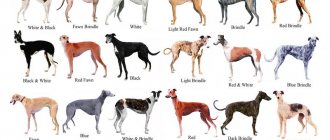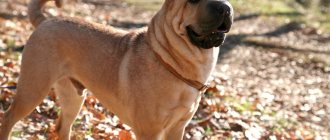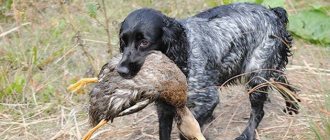Spaniels are a large group of breeds, which includes such representatives as the Cocker Spaniel, Field Spaniel, Welsh Springer, Irish Water Dog, German Wachtelhund and others.
Most people associate the word “spaniel” with hunting dogs, but Tibetan spaniels are an exception.
The British named the representatives of this breed this way only for their external resemblance to those popular at the beginning of the 20th century. continental toy spaniels.
These dogs can be good watchdogs, but their main purpose is to be faithful companions.
Origin story and what it looks like in the photo
Tibetan spaniels are an ancient breed of dog; the first mentions of animals similar to them date back to around the 8th century. BC e. Representatives of this breed were companions of monks and served to guard monasteries, announcing the visit of strangers with loud barks.
Previously, these dogs were considered sacred and were not sold; a puppy could only be received as a gift.
Over time, Tibetan spaniels came to China and other countries where Buddhist traditions were observed, but in the West they were not aware of their existence for a long time.
The first individuals of this breed came to Europe in 1890, their debut at an exhibition in England took place in 1898, but they became widely known only after 1920, when one English breeder began to actively promote the breed.
The Association of Tibetan Spaniels was created in 1957, it was thanks to it that the English Kennel Club officially recognized the breed in 1959, which significantly accelerated its development and already in 1965 the number of registered individuals increased to 165, which significantly improved the situation for Tibetan Spaniels. spaniels after the Second World War.
It is still unknown exactly who the ancestor of the Tibetan spaniels was . Most dog experts believe that these were Pekingese and Shih Tzu, but there is also an opinion that pugs were used when breeding the breed.
Historical reference
The Tibetan Spaniel is a small dog with a very long and winding history. Representatives of the breed were common in the monasteries of Buddhist monks and served as companions and protectors. The Tibetan spaniel served as a valuable gift, which was presented only to very important guests. Today, Tibetan spaniels are considered a very rare breed, but are valued by their fans for their keen intelligence and attention.
The Tibetan Spaniel is said to resemble a small lion, which is a symbol of Buddhism. The four-legged animal remains constantly vigilant and performs the functions entrusted to it. Despite their size, dogs are wary of strangers and fiercely display a protective instinct.
Even in the Ancient Chronicles of the monks it is noted that Tibetan spaniels are very sensitive and intuitive. The dog feels its owner well, is very worried about family problems and shows a very caring attitude towards children.
This is interesting! The early ancestors of Tibetan spaniels were known in ancient Asia. Rock paintings of dogs with luxurious fur and lion heads have been discovered in both Tibet and China.
It is believed that monks were involved in breeding Tibetan spaniels. Why such miniature dogs were used for protection is easy to explain: a small dog is easier to feed, and the Tibetan spaniel, which has a lush mane, looks like a lion. In Tibetan culture, the lion is revered as a symbol of strength and courage.
The similarity of the Tibetan Spaniel with the common Pekingese is explained by the fact that puppies were sometimes given to foreign guests. The first Tibetan Spaniels were brought to China and Japan, where they were crossed with Pekingese and Japanese Chins. Unlike its successors, the Tibetan Spaniel became known in the world much later.
The Tibetan spaniel was first bred outside of Asia at the end of the 19th century and presented to an English countess. Naturally, the nobility became interested in the new breed and in 1920 several more spaniels were introduced into England. The breed began to gain popularity in narrow circles of the English nobility and is increasing in number. However, during the Second World War, Tibetan spaniels were almost exterminated in England.
The restoration of the breed in England began in 1947. After receiving several litters, the first breed club was organized. The English Kennel Club recognized the breed in 1960.
Next, cynologists from America took part in the spread of the breed. In 1965, the first Tibetan Spaniel was imported into the United States. Naturally, in America the dog also attracted the attention of connoisseurs and nobility. One of the first owners of a Tibetan Spaniel puppy was the later famous breeder Jay Child. The breeder dedicated her life to the development of the breed. The American Kennel Club recognized the Tibetan Spaniel in 1984.
Interesting to know
- Despite the fact that Tibetan spaniels learn new commands quite quickly, they can carry them out at will.
- They shed a little throughout the year, twice a year profusely.
- They get along well with children, but are better suited for older children, as they can easily suffer from rough handling.
- Get along well with other dogs and cats.
- They love family and attention, Tibetan spaniels are not recommended for families where they will not be given much time.
- They require moderate activity and are quite happy with a daily walk.
- You need to walk on a leash to prevent escape. They like to wander and not listen to the owner at this moment.
- Buying a Tibetan spaniel is not easy, as the breed is rare. There is often a waiting list for puppies.
Description and standard
Tibetan spaniels are miniature dogs with a squat, elongated, muscular body and a flattened muzzle. Representatives of this breed are very similar in appearance to Pekingese and Shih Tzu.
Breed standard:
- the head is small relative to the body;
- the skull is dome-shaped, the stop is smooth but pronounced, the brow ridges are clearly defined;
- muzzle of medium length;
- bite - snack;
- nose is black;
- the eyes are round, set wide, set at stop level, the iris is dark brown;
- ears are hanging, set wide and high;
- the limbs are short, the hind limbs are stronger and more muscular than the forelimbs;
- The back is straight, the loin is short, the croup is strong and sloping.
- The chest is wide but not deep, the ribs are well sprung.
The coat is of medium length, fine, silky and soft; the undercoat of males is thicker than that of females . There are decorative featherings on the ears, neck, tail and back of the paws.
Character traits
Tibetan spaniels are cheerful, cheerful and active dogs, whose guarding purpose is a thing of the past and now they are used only as companions and family pets.
They are able to capture the mood of their owners and always strive to be there if someone is sad . Due to their high sensitivity and intolerance to noise and screams, Tibetan spaniels do not get along well in families where quarrels and scandals often occur.
Representatives of this breed are smart, quick-witted and willful. To establish a friendly relationship with your pet, you need to give him maximum attention and respect his personal space without limiting his freedom.
It is keeping in a limited space that has a negative impact not only on the character of the animal, but also on its physical and psychological development.
These dogs love people, are devoted to the owner and all family members, but treat strangers with suspicion and distrust.
Tibetan spaniels are always on guard at home and, despite the fact that they cannot resist the offender due to their miniature size, they will not fail to inform the owner about the visit of a stranger with a ringing bark.
Expert opinion
Kozhevin Semyon Kirillovich
Expert dog handler.
Do not be fooled by looking at the miniature size of these dogs and think that they do not need training or that this issue cannot be approached very responsibly. Tibetan spaniels are very obstinate and stubborn; obedience can only be achieved from them through education and early socialization. This process is simplified by the fact that representatives of this breed are not prone to dominance, which means the owner does not need to compete with the pet for the position of leader.
Tibetan spaniel and man
The body of a Tibetan spaniel contains the spirit of a large watchdog. More often they play the role of a pet, but can notify their owners about violation of the territory with a ringing bark. By the way, Tibetans do not vote unless necessary. Patient, hardy, can withstand long walks.
These dogs will not be able to sleep all day next to a person. Thanks to the breed's past, in which tibbies were outdoors in any weather, they do not freeze in severe frost, and their coat protects them from high humidity and precipitation. Unlike Pekingese, they do not suffer from heat.
Tibbies are affectionate with the inhabitants of their home. Children are treated with care. They do not show aggression towards other animals. The vast majority of Tibetan Terriers live with active, middle-aged people.
Spaniels from Tibet are able to relieve human stress and tension. They are compared to cats in terms of their therapeutic abilities. In Western countries, tibbies are trained for use as part of canistherapy.
Advantages and disadvantages
Tibetan spaniels are reserved dogs with a strong nervous system and a balanced psyche, which is especially important for families with small children.
Also, the advantages of these dogs include:
- intelligence and intelligence;
- devotion;
- ability to get along with other animals and children;
- lack of aggression;
- ability to adapt to weather changes;
- playful and affectionate disposition;
- unobtrusive behavior;
- security qualities.
The ability of these dogs to relieve nervous tension in people led to their use in the canistherapy program.
Cons of the breed:
- need for attention;
- the need to have free space;
- self-confidence;
- stubbornness and willfulness.
In addition, these dogs are hyperenergetic and need regular active walks and exercise..
Key points in training
Despite their small size, dogs, like others, need good upbringing and training. To teach Tibby to obey, it is important for the owner to show leadership qualities and force him to accept that the person in the house is more important than the pet. From an early age, from the age of one month, the dog is taught to eat by the hour, go to the toilet in one place, and designate its territory (where to sleep, where to eat).
Tibetans will not need all the commands; the standard ones will suffice: “sit”, “no”, “near”, “voice”, “quiet” . You only need to call your pet by name, then he will quickly remember the nickname.
Read about how to properly train a dog in the article: “Training a puppy: effective methods from dog handlers, learning commands at home.”
When trying to deviate from the rules: begging or disobedience, the pet is punished (deprivation of treats, shortening of the walk). The use of brute force is prohibited.
Color variations
The official breed standard allows any coat color of Tibetan spaniels. Most often there are individuals with fur of black, golden, red and all shades of brown.
Both the presence of transitions and play of tones, as well as solid colors, are acceptable, but there are practically no such dogs; more often there is a combination of three or more colors.
Particularly valuable are individuals with dark fur and a white spot on the chest, which, as Tibetan monks believed, is a symbol of a pure heart.
A white spot located on the forehead is considered a sign of the Buddha's favor, and a white tail indicates the dog's thieving tendencies.
a brief description of
- Other names: Tibetan Spaniel, Simkhyi, Tibbie, tibbie.
- Height: 25-26 cm.
- Weight: from 4.0 to 7.0 kg.
- Color: Any coat color is acceptable, white spots on the paws are acceptable.
- Coat: double coat with thick undercoat, thick, silky, long along the neck and tail.
- Life expectancy: up to 16-18 years.
- Advantages of the breed: Tibbies have a loyal character with a sufficient level of intelligence. A characteristic feature of the breed is considered to be an active life position and courageous actions.
- Difficulties of the breed: Dogs are stubborn and overly self-confident. A high level of energy forces the owner to spend more time walking or playing active games.
- Price: up to 1000 euros.
Is he good with children and does he get along with other pets?
Like other representatives of decorative breeds, active and inquisitive tibbies get along well with children and quickly establish friendly and trusting relationships with them, but only if they behave correctly and respectfully.
Representatives of this breed are not characterized by aggression, they are friendly towards everyone and do not feel the need to prove their leadership, therefore they get along well with other pets, perceiving them as part of their family.
How to properly care
Representatives of this breed are suitable for apartment living if they are provided with the necessary level of physical activity and regular active walks.
Caring for a Tibby is not difficult, but it must be done regularly to maintain the dog's attractive appearance..
Wool and bathing
Representatives of this breed shed throughout the year, especially heavily during shedding, so they must be thoroughly combed daily to get rid of dead hairs and avoid the formation of tangles.
Your pet should be bathed 3-5 times a year, using a hypoallergenic shampoo and conditioner selected according to its coat type..
Eyes
Every morning, wipe with a napkin or cotton pad soaked in chamomile infusion or boiled water.
Puppies often experience increased lacrimation, which goes away as the dog gets older..
Claws
If the claws do not grind down on their own, they must be trimmed with a guillotine nail clipper every 3-4 weeks so as not to touch the blood vessels. The sharp edge should be smoothed with a nail file - this will help avoid cracking of the claw.
Ears
Inspect and remove accumulated dust and wax weekly by wiping the inside of the ear with a cotton pad. It can be dry or soaked in peroxide or a special lotion.
Teeth
To avoid the formation of plaque and tartar, you need to brush your pet’s teeth at least twice a week, and preferably daily, with a special brush and toothpaste for dogs.
Care and maintenance
Such a dog can only be kept indoors, both in a house and in an apartment. Tibby is not large and easily lives in small city apartments. But for harmonious development, he needs his own place and a little personal space. Therefore, it is better to think in advance where to organize a place for the puppy so that he can hide from prying eyes.
Purchase a cozy indoor lounger or house, bowls on stands for height adjustment, combs, toys. The breed is not difficult to maintain, but regular walking, veterinary care and quality nutrition are the key to healthy development.
Nutrition
The problem of the breed is allergic reactions to food, so the diet for representatives is prepared especially carefully. The menu can be made up of dry food or natural food.
The first option is suitable for owners who do not have time for frequent cooking and have the finances to purchase a high-quality product.
Dry food is classified according to a special system: economy, super, super-premium, holistic, human grade (fit for human consumption). Tibetans need a super-premium or holistic class for dogs with allergies. If there is information about the exact products that cause the disorder, then the composition can be subtracted.
Natural feeding is cheaper, but will require time spent selecting ingredients for the menu and preparing them. It does not contain all the necessary minerals, so vitamin supplements will be required.
The daily diet consists of 2/3 proteins (meat, eggs, sea fish, dairy products). Tibetan Spaniels need rabbit, lamb, and turkey. The rest of the serving is grains and fats (rice, buckwheat, oatmeal, vegetable oils). Cereals are boiled in water without salt or seasonings. It is recommended to accustom your pet to vegetables and fruits.
Human food is prohibited: fatty, fried, salty, sweet, flour. The list of harmful foods includes: pasta, bread, potatoes, pork, butter, sugar, chocolate, citrus fruits, legumes, bones, cabbage.
An adult dog is given food 2 times a day, 300-400 g each. The volume depends on weight, activity and time of year (less is needed in summer). If the pet does not finish eating, then the portion is reduced, and if it requires more, then it is increased. Puppies 3-5 months old are fed 4 times , 6-8 months old - 3 times . Then they are transferred to standard nutrition.
Bowls are washed after each meal. The drinking bowl is always filled with clean water.
We recommend that you read a detailed article on the topic: “How and what to feed a dog: types and characteristics of nutrition.”
Health
The breed's gene pool is small, and therefore its health is fragile, but with proper care, regular vaccinations and veterinary examinations, Tibbies live up to 12-15 years. What needs to worry is those owners who bought a puppy from a private person and do not have information about the baby’s parents.
Vaccinations
There are mandatory vaccinations and those recommended during peak incidence. Mandatory vaccinations include:
- enteritis;
- parainfluenza;
- carnivore plague;
- hepatitis A;
- leptospirosis.
The vaccine is administered at 2, 2.5 , 6 months, repeated at 12 and annually ). Mandatory rabies vaccination is done at 7 months , after changing teeth, and annually . Without these injections, the dog is considered dangerous to people and cannot be transported across the border.
Additional vaccinations (mycoplasmosis, lichen) are carried out by veterinary clinics in conditions of increased infection in the city or region.
Each owner draws up a vaccination schedule, based on the recommendations of the breeder or veterinarian, and receives a veterinary passport after the first procedure. All injections and bottle labels are placed there.
2 weeks before vaccination, the pet is cleaned of internal parasites. On the day of the procedure, the temperature is measured to check health, only healthy animals are vaccinated. All injections are carried out under sterile conditions by specialists or experienced dog breeders.
After vaccination, you may experience lethargy, lack of appetite, soreness at the injection site and a small bump. If symptoms last longer than 3 days, you should contact your veterinarian. An allergic reaction manifests itself immediately (salivation, convulsions, rashes), in which case you should contact a specialist immediately.
Important article on the topic: “Everything you need to know about dog vaccinations.”
Diseases
The most common problem of Tibetan Spaniels is food allergic dermatitis and other irritations: gastrointestinal imbalance, seizures. In addition, animals have a non-standard physique, which causes other diseases:
- Intervertebral hernia (due to a stretched body and improper physical activity);
- Hip dysplasia (excessive load on the hind limbs, heredity);
- Shortness of breath, breathing problems (due to the structure of the muzzle).
With unbalanced physical activity, heart problems appear: disturbances in the functioning of the valves, angina pectoris.
Walk
These animals are active, mobile, but physical activity can play a cruel joke and lead to health problems. Therefore, the schedule of walks and training should be clearly planned. Adult Tibetans need 2 walks a day with moderate play and jogging, without jumping on their hind legs. Average duration is 30-40 minutes.
Babies are walked after the second vaccination, carried in their arms for 10-15 minutes 2-3 times a day . By 2.7-3 months they begin to accustom them to a harness and leash, introduce them to the surrounding area, dogs, people, and socialize them. The pet should not get tired, so it is better to postpone long trips until it is fully grown.
Grooming
Dogs shed all year round, especially actively in the spring and autumn. They need brushing 3-4 times a week with a medium-hard brush. It is better to lift the main coat, brushing only the undercoat.
There is no need to cut your pets' hair, just remove sprouted hairs between the pads. Bathe as needed, no more than 3-5 times a year using dog shampoo and conditioner, then dry with a hairdryer at medium speed and temperature. After walks, wash paws.
Ears and eyes are examined daily and wiped with a cotton swab every 2-3 days. Teeth are cleaned of plaque with special chewing treats or paste. Claws are trimmed if they do not grind down on the asphalt on their own.
Mandatory treatment for helminths and ectoparasites is carried out once a trimester.
Life expectancy, health and major diseases
Tibetan spaniels live on average 12-15 years.
The small gene pool has made representatives of this breed prone to a number of pathologies, which are most often hereditary in nature or develop as a result of improper care of the pet.
Most often these dogs are diagnosed:
- food allergy attacks;
- dermatitis;
- hip dysplasia;
- intervertebral hernia;
- respiratory system diseases;
- angina pectoris;
- disturbances in the functioning of the heart valve;
- progressive retinal atrophy;
- ear diseases;
- conjunctivitis;
- cataract;
- glaucoma;
- gastrointestinal imbalance;
- convulsions;
- cardiomyopathy;
- primary lens luxation;
- turning of the eyelids;
- districhiasis;
- dislocation of the kneecap;
- urolithiasis.
In order to be able to detect the disease at an early stage of development and begin timely treatment, it is necessary to visit the veterinarian twice a year for routine examinations and monitoring the pet’s health.
How much does it cost and where to buy
Popularity has bypassed Tibetan spaniels. Back in 2011, there were several nurseries in Russia, and only a few specimens were present at exhibitions. Today the number of tibbies has increased. Russian breeders offer to purchase a Tibby puppy with RKF documents for an average of 40,000 rubles .
The price is higher abroad. In Finland and Estonia, the Tibetan Spaniel breed is most widespread. It’s easier to choose and buy a puppy there. In Finland, a database of breeds has been created and regularly updated, where information about the dates of life, relatives and diseases of each dog is entered.
Nutritional Features
The type of food a dog chooses depends on the owner . These can be natural products or industrial feeds, the main thing is not to mix them in one feeding and ensure that the diet is balanced.
With natural feeding, the owner has the opportunity to control the quality of the products and be sure that all the nutrients entering the dog’s body are of natural origin and are better absorbed.
Must be given to your pet:
- lean meats;
- offal;
- sea fish;
- cereals (oatmeal, pearl barley, buckwheat);
- vegetables and fruits;
- low-fat fermented milk products.
IMPORTANT!
It is necessary to give your dog additional vitamin and mineral supplements.
It is forbidden to feed Tibetan spaniels:
- fatty meat;
- river fish;
- potatoes;
- legumes;
- sweets, baked goods;
- bones;
- bakery and pasta products;
- spices, pickles;
- smoked meats, sausages.
When choosing a diet based on industrial feed, you should choose products that are no lower than premium, or better yet, super-premium, the composition of which is enriched with all the vitamins and minerals necessary for the healthy growth and development of your pet.
The most popular food brands among breeders are Acana, Hills, Go, Pro Plan, Eukanuba, Royal Canin..
It is important to understand that whatever the diet, it is necessary to select it, as well as the volume of portions and frequency of feeding, taking into account the age, activity level, health and physiological state of the dog.
You also need to remember that Tibetan spaniels are prone to food allergies, and older dogs are also prone to obesity.
Education and training
It is better to conduct classes in a playful way, not forgetting about rewards in the form of treats. This way “tibby” will remember all the commands faster.
Dog trainers are inclined to believe that the Tibetan spaniel has average training abilities, but in practice, training this dog does not require repeating commands several times for the pet to remember them. In fact, the furry cunning one understands his owner very well, but his freedom-loving and independent disposition and natural stubbornness significantly complicate the upbringing process.
Therefore, training and socialization should begin as early as possible. The owner will have to be patient and make remarkable efforts in order to force the disobedient animal to obey the first time. To do this, you need to establish yourself in the role of leader and leader, not allow disobedience, but also not physically punish the dog if it disobeys.
Various and interesting activities with a trainer in a playful way can come to the rescue. This will make it easier for tibbies to learn basic commands. You should not skimp on praise, treats and affection.
How to choose?
If a puppy is bought only as a pet, you don’t have to make any special demands on its appearance.
You only need to ensure that the future pet is healthy by carefully examining it and making sure that there are no symptoms of pathologies such as lameness, skin rash, exhaustion, nasal discharge, unpleasant odor from the ears, etc.
If the purpose of purchasing a dog is to participate in exhibitions or breeding, it is necessary to choose it as carefully as possible..
You should make sure not only of the puppy’s health, but also of its compliance with the breed standard, assessing its proportions, bite, and coat type. The muzzle should be flattened, but without folds, the ears should be hanging and high-set, the eyes should be oval, with a dark iris.
The baby should be cheerful, playful, perky, not show aggression, behave friendly and active.
Price range
Due to the small number of this breed and the growing demand for its representatives, breeders keep prices for dogs quite high - the cost of puppies on average is 25-45 thousand rubles.
Promising individuals that ideally meet the standard are somewhat more expensive, but a baby without a pedigree or having any defects in the exterior can be purchased for about 15 thousand rubles.
Behavior and temperament
Tibbies are intelligent and reserved in their emotions towards other dogs. They are sanguine by temperament, and have a strong nervous system.
Positive traits:
- Devotion,
- Developed intelligence,
- Activity,
- Courage.
Disadvantages include:
- Excessive self-confidence
- Excess energy
- Need for increased attention (games, activities),
- Stubbornness.











